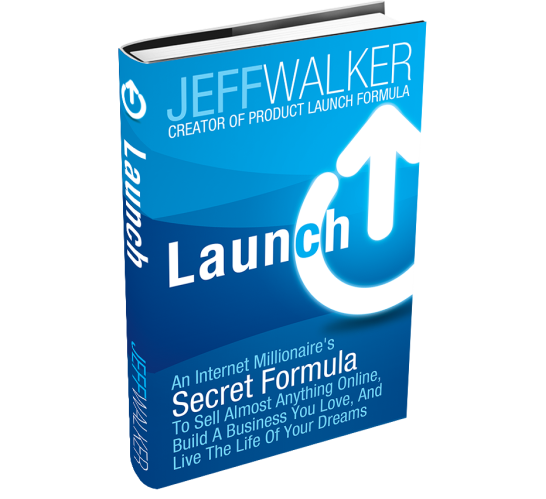How do you use content marketing and storytelling to launch a new product or business?
The strategy, according to Internet marketer Jeff Walker’s latest book Launch, lies in creating the right sequences, telling the right stories through content marketing, and incorporating the right mental triggers.
Based on his Product Launch Formula (PLF), the book shares how one can successful launch online businesses just like Jeff, his clients and students.
Subtitled An Internet Millionaire’s Secret Formula to Sell Almost Anything Online, Build a Business You Love, and Live the Life of Your Dreams, the easy-to-read book is written from Jeff’s own experience in Internet marketing.
It is packed with case studies and anecdotes on how the PLF helped Jeff and his students to “print money”, transform themselves from “stay-at-home dad to six figures in seven days”, or make “a million dollars in a single hour”.
The Product Launch Formula (PLF)
So what is the PLF?
Inspired by the storytelling and episodic content marketing strategies of Hollywood blockbusters, the PLF is made up of sequences, stories and psychological triggers primed to cut through the “communications fog” (aka clutter). It is considered by many to be the “bible” for email marketing and Drip Marketing – where bits of information are sent to leads and prospects to nurture them and eventually lead to a sale.
It comprises a sequence of content and communication “bursts” as follows:
1) Pre-Prelaunch
Start by building anticipation among your most loyal fans. Ask questions or conduct surveys to figure out how receptive the market will be to your offer. Use fan input to tweak your final offer.
2) Prelaunch Emails
Next, you should “romance your market” by emailing them three pieces of high-value content. This activates mental triggers like authority, social proof, community, anticipation and reciprocity, and answer objections.
Typically released over 5 to 12 days, content formats vary. They include video (preferred) to audio, blog posts, PDF reports, webinars, slides and more.
3) Launch Emails
Also known as “Open Cart” (because your shopping cart literally opens!), the launch covers a quick succession of content delivered via emails. These are released over a range of 24 hours to seven days.
The first launch email would say something like “We’re open, you can finally buy now”. This is followed in succession by sequential emails which take on greater and greater urgency (“Only two days before your special offer ends!”) before the launch is shut down.
By doing so, you create a sense of scarcity – an important trigger for propelling sales.
4) Post-Launch Emails
This follow up step is critical. It could significantly increase the life-time value of customers.
New clients should be thanked. If possible, they should be offered bonuses that further delight them. Feedback from prospects who didn’t buy should also be sought soon after the launch.
Seed Launch and JV Launch
From the PLF, various permutations could be used depending on one’s business needs.
Start-ups or businesses with new products could invoke a Seed Launch. Through email marketing, content marketing and community building strategies, such businesses can create a small initial list and build it up from there.
More established companies could do a JV Launch. This involves working with affiliate partners with established email lists or well-trafficked websites on cross-marketing promotions.
Activating 9 Triggers of Influence
The PLF’s success is credited to using social and mental triggers commonly employed in influencer marketing (read Cialdini’s 6 Weapons of Influence in Who’s Your Influencer?).
A total of nine triggers of influence were cited in the book, namely:
- Authority: Through teaching and training one’s potential customers, authority could be built;
- Reciprocity: Delivered by providing valuable content to prospects every step of the way;
- Trust: Earned through building relationships with prospects and giving value as part of an online community or email list;
- Anticipation: Built by layering information one on top of another, and leading prospects along a content marketing funnel with a carefully crafted storyline and increasingly valuable content (see the content marketing funnel here);
- Likeability: Gain influence by interacting with one’s fans and giving value;
- Events and Ritual: Pulling everybody along as members of a team, where they feel a part of something bigger than themselves;
- Community: Fostering camaraderie, friendship and relationship amongst members of a group (a critical part of influence);
- Scarcity: Creating the perception of scarcity so that people would make a decision; and
- Social Proof: Allowing people to “like”, comment and share one’s content, hence demonstrating that others have used or bought the product.
The Power of Email Lists
Equating list building to a core strategy in marketing, Jeff strongly recommends businesses to build their database of email subscribers.
Claiming that “email is at least 20 times more powerful than a Facebook list”, he suggests the following pointers:
- Understand to whom we are selling to;
- Create a “squeeze page” (aka a landing page to capture email addresses) with an “opt-in bribe” of valuable content to sign up for an email list;
- Provide a very strong value proposition; and
- Should they decide not to opt-in, they should be allowed to leave the page.
I feel that compelling a web visitor to subscribe or leave is too drastic. While it filters out less-interested parties, it may repel those sitting on the fence and discourage them from finding out more. I guess this is why I not impose such a rule.
Having said this, I’m sure it may work in certain instances, as seen by the testimonies shared by Jeff’s students and clients.
Success Stories of PLF
Like The Four Hour Workweek, $100 Startup and other similar Internet start-up books, Launch shares the dream of becoming an itinerant Internet entrepreneur unbound by time or place.
This was vividly portrayed by Sebastien Night. Sebastien used PLF to build a series of online businesses catering to the French-speaking market. By doing so, he could take a six-month trip around the world with his fiancee while working one day a week.
The other story which resonated with me was that of John Gallagher. John borrowed $20,000 from his dad to launch a wildcrafting board game from his basement. By using the PLF, John launched a series of products ranging from a herbal kit and paid membership site to video courses.
Marrying Content and Email Marketing
Personally, I found Launch an insightful tour into the world of Internet marketers offering information products. Many personal development gurus like Brendon Burchard and Robin Sharma have used such methods to great success.
As an information and content marketer, I found its approach to building businesses through sequential storytelling and mental triggers is worth noting. It was also a great idea to provide useful content via email to build a more sustainable online community.
However, I would probably advocate a less “hard hitting” approach when marketing to Asian consumers. My preferred approach would still offer value, but I’ll skip making huge claims. Culturally, one to one interactions – preferably in the flesh – may also be needed here.
For more valuable tips and content, do check out Jeff Walker’s blog here.
Jeff Walker (courtesy of Snapp Corner PR)


